by katie | Feb 5, 2016 | Blog, How I make my hand woven teddy bears
The set of threads that travel from the front of the loom to the back is called a warp. This needs to be made separately before it is placed on to the loom and this is what I am going to talk about in this post.
The warp sets the length, width and density of the fabric. It makes up half of the threads within the finished woven fabric as it will become all of the vertical threads in the finished woven fabric.

Warp being wound on warping mill
Before making the warp I have to decide exactly how much fabric I need to weave, the length and width. Normally I will weave several pieces of fabric from one warp so this needs to be planned first. The density of the fabric needs to be worked out which is the number of threads in every cm of fabric. This is very important because if the fabric is too open then it will not hold together when being made into a teddy bear and if it is too dense then the colours of the yarn will not show evenly in the finished hand woven fabric.
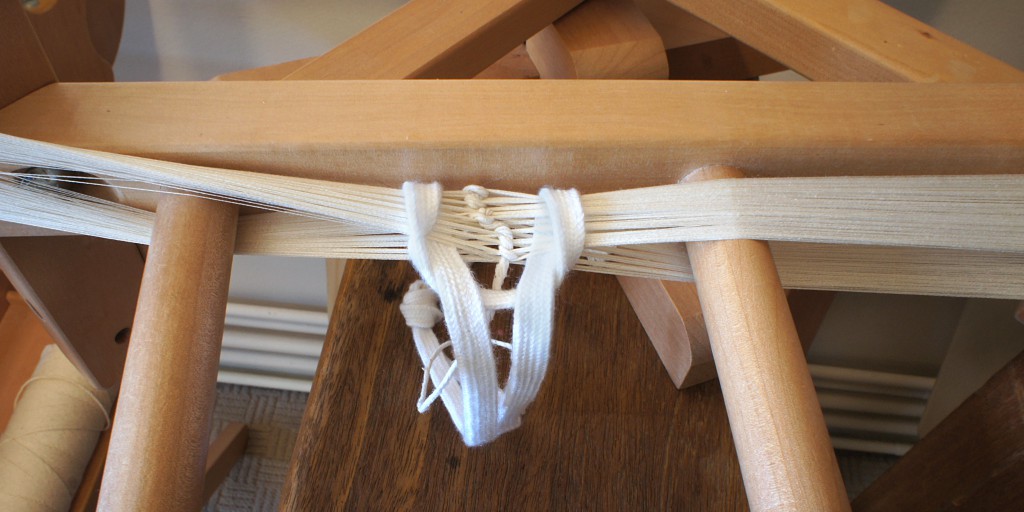
Threads being organised and counted into groups on the warping mill
I make my warps on a warping mill which allows me to organise the right number of threads in to the length required. The number of threads varies and can be up to 800 for my teddy bears.
Depending on the thickness of the yarn and the length/width of the fabric to be woven this often takes between one and half and three hours to complete.
Once complete the warp is removed from the warping mill and chained (see image below) to ensure it does not tangle. This is now ready for the loom.
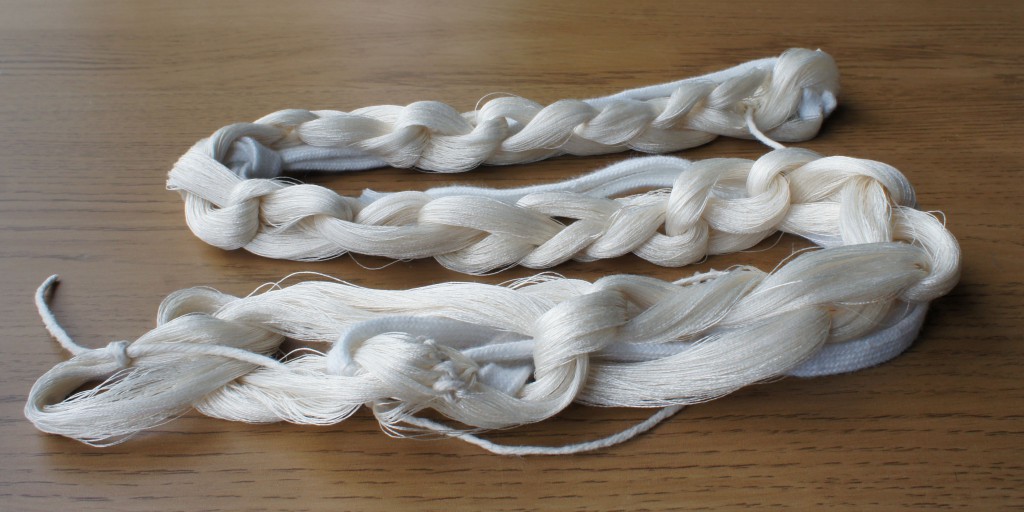
Chained warp
Have a look at the next step – Setting up the loom
by katie | Jan 29, 2016 | Blog, How I make my hand woven teddy bears
People always ask me how I make my handwoven teddy bears so I am doing a series of blog posts explaining just that.
Making each teddy bear can be a long process which takes approximately 20 hours per bear to make.
The first step, before weaving commences, is to decide what sort of fabric to weave and what the teddy bear will look like. There is a huge selection of yarn to choose from and getting the right one is important as it will determine the whole look and feel of the finished teddy bear. Some of the yarns I use include worsted wool, alpaca, silk and Tencel.
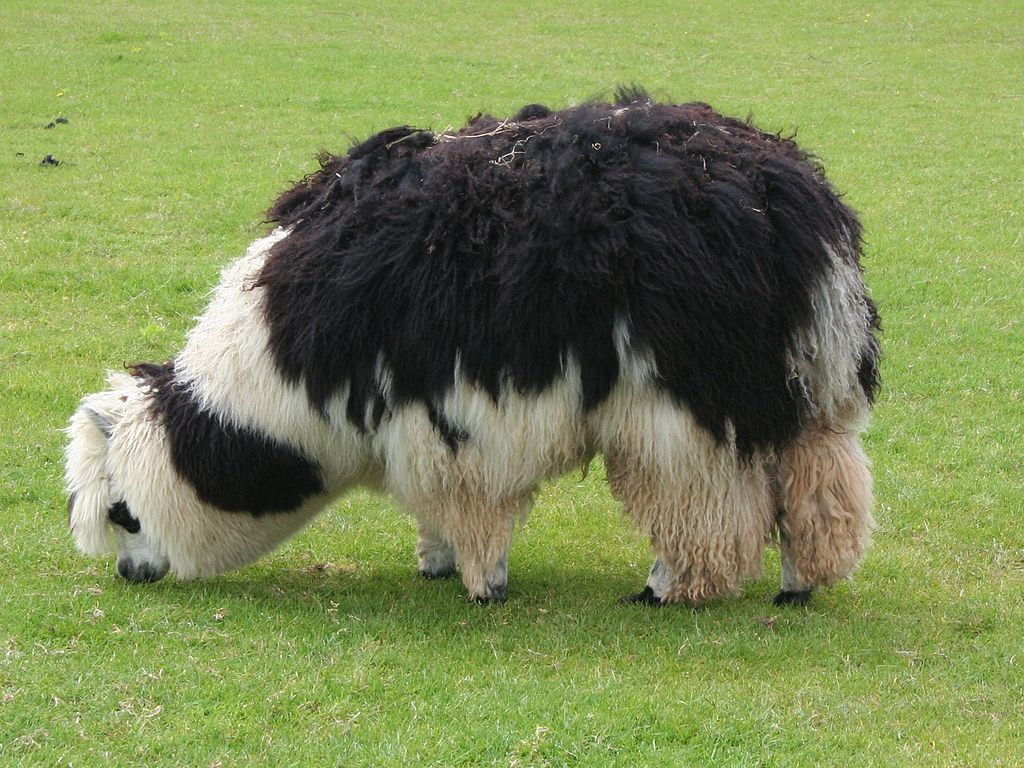
Alpaca
Before I start I ask myself a list of questions; What yarn will I use? What colours will it be? How much fabric will I need? What structures will I weave? What is the final handwoven teddy bear going to look like?
Inspiration for the bears can come from anything around me, it may be a pattern I see in nature or colours from a trend magasine. I also do commissions where the design of the bear is customer lead.
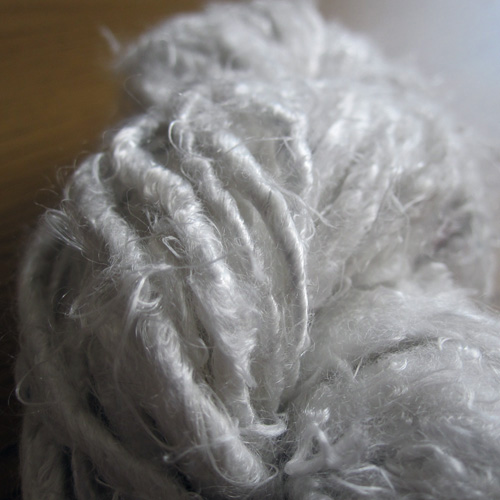
Banana Yarn
I hand-dye a lot of my yarn so that I can get precise colours, each new colour needs to be tested and documented. Sometimes it can take three or four attempts to get the correct shade or hue of colour.
When I am ready to dye the yarn for the handwoven fabric I accurately work out how much I need and arrange the yarn in to skeins (large rings of yarn) which enables me to dye the yarn evenly.
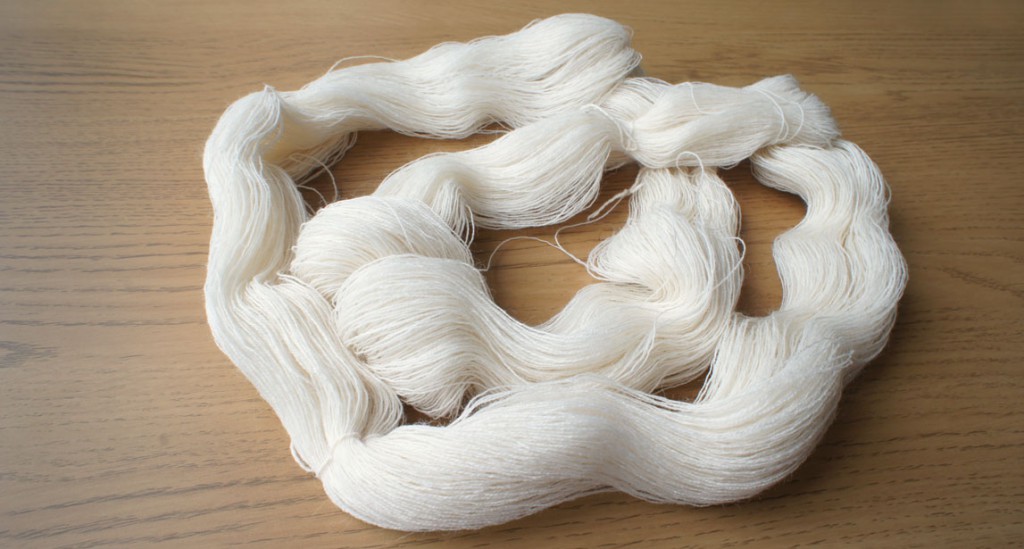
Skein of yarn ready to be dyed
The yarn is scoured/washed before being dyed to remove any natural oils or coatings. Depending on the type of yarn this may involve washing with a detergent or boiling the yarn.
The dyeing process is different for the different types of yarns but takes anything between one to two hours plus drying time. There are various ways of applying the dye and the most common method I use is creating a dye ‘bath’ made up of dye powder and fixing chemicals which the yarn is immersed into.
Other methods include dipping different areas of the yarn into different colours to create a graduated effect, tying areas to resist the dye or painting the dye on to the yarn using a brush.
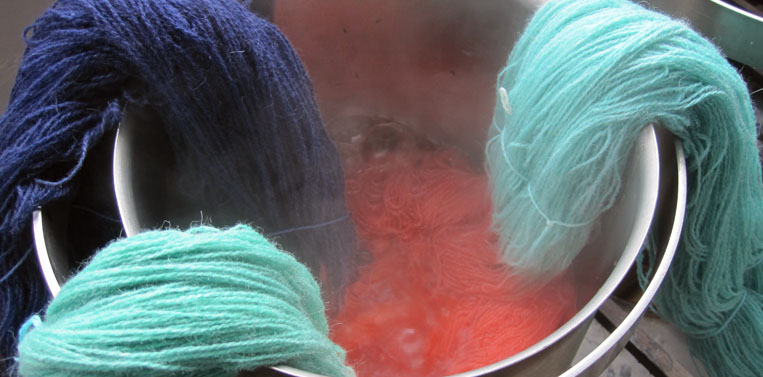
Geelong lambswool/angora mix yarn being dip dyed multiple colours.
Have a look at the next step – winding the warp
by katie | Nov 27, 2015 | Blog
I recently went to the SIT Select Showcase and talks, it was great day filled with creative people.
The Showcase was basically a craft fair but the standard of work was amazing. My two personal favourites were Mayumi Keneko and Helen London. Mayumi Keneko hand weaves fabric using paper yarn and folds the fabric in an origami-type way. My favourite pieces she had out on display at the Showcase are unfortunately not on her website. These pieces were small creations folded in to detailed shapes in the traditional origami way, beautiful and intricate. Helen London is a silversmith who produces wonderfully delicate silver jewellery.
There were a lot of interesting speakers there too, I went to talks by Mary-Rose Watson, Penny Wheeler, Ismini Samandou, Jilly Edwards and Theo Wright.
Mary-Rose Wheeler‘s work is very interesting, as a weaver she uses a warp and a weft but not on a loom and not always interlinking. She creates her work on a frame by wrapping the warp and weft around it simultaneously. At first the three dimensional nature was coincidental but she has now developed and enhanced this aspect. She dyes all of her own yarns and only uses rayon, she likes the way the light reflects and changes the colour. My favourite collections are the Feather series and Pennine series. I am not so keen on the pieces where she has added extra yarn, I feel it distracts from the beautiful simplicity of her work.
Penny Wheeler is a weaver and artist. She has worked on many interesting projects including growing herbs in a shift dress. She was part of the Z Twist project celebrating the high quality textiles produced in Somerset. The Quantock Weavers were also an inspiration for one of her projects where she wove fabric based on stones.
Ismini Samandou‘s work is all about reproducing natural surfaces through woven textures, mostly using a Jacquard loom. Before she started weaving her main interest was in photography. She is always trying to create something new that no one has done before. Currently, she is very interested in clouds and time, and where you are in relation to these. Textiles with a narrative and meaning, and the God of Arachne are also very influential. She has completed many residencies including with the Crafts Council in Bangladesh and an Anni Albers residency in Connecticut. Her work is beautiful and well worth a look.
Jilly Edwards is a tapestry weaver who weaves on a range of scales. The very large scale pieces are produced on scaffolding that she has bought for her studio space. Her inspiration comes from her constant collecting of ‘stuff’ she finds anywhere and everywhere as well as her drawing. When she weaves her pieces (all sizes) she creates a drawing to scale to place behind the tapestry as she is making it.
Theo Wright, for most of his life, has been a computer scientist and greatly interested in mathematics. 30 years after he started his Computer Science degree he started his Textiles degree. He realised his interest in textiles when he looked back at all of the things he had collected from travels and realised that they were all textiles based, he was also knitting as a hobby. He taught himself to weave as a hobby at home before pursuing a degree. His woven work is all based on his mathematics interests, using permutation theories to work out and arrange his threading and weaving structures. Instead of using weave programs to design structures he uses Excel, creating equations that will produce many different designs for him. Colour isn’t a major part of his work, the thing he focuses on is contrast, his use of light or dark yarns. For me his work is not so pleasing visually but the way he uses mathematics in weaving is fascinating.
My day at the SIT Select showcase was very inspirational. Going to events like this keeps me excited about textiles and craft, and my motivation high.
by katie | Nov 13, 2015 | Blog
I attended a very interesting talk by the illustrator Bevery Philp. Illustrators create images for a wide variety of industries including computer games, advertising, packaging, textile design, books, graphic design, web design, the list goes on and on.
Beverly Philp started out doing a graphics degree, her tutor at the time was Rayman Briggs who is the illustrator for The Snowman books. Drawing was a huge part of the course along with printmaking, bookbinding and photography which are fundamental skills she continues to build upon.
Her success started when she finished uni and visited lots of companies to show them her work. It was her doll photography that caught their eye. She would make clothes, accessories and sets for dolls, making them up to look like celebrities. After some time she found that this was not very cost effective due to the huge amount of hours that needed to go into each doll so she decided to go back to uni to do her MA at the Royal College of Art.
During her MA she focused more on drawing and photography, producing two documentary books, Alfie and haircut. These again were a success when she finished her MA and can be seen on her website below.
She is constantly drawing, sketchbooks are a vital part of her work and she finds that she learns a lot about herself from looking at these. Her sketchbook is full of drawings of people and all using quick lines in black pen. Sometimes she will talk to the people she draws to enable her to understand them better and incorporate their personality in to her sketches.
As well as the black line drawing she experiments in her studio with different ways of drawing such as drawing something upside down or using lemon juice and baking it. This allows her to broaden the types of illustrations she produces.
Her final illustrations are very loose and and use a lot of texture. The textures she uses are all ones she collects, makes or prints herself. The illustrations start out with the hand drawn images and the textures separate, she uses a computer to put them together and play with the imagery.
Beverly does a lot of work for magazines and newspapers where she has to work to very tight timescales. For these she has to get rough sketches for her initial thoughts done within days to send through for approval. She then works on the ones they like. Working with publishers gives her projects with longer timescales.
From listening to the talk it was clear she is a lovely down to earth person who has to work hard to continue the work she loves.
Her illustrations really are beautiful and worth a look:
www.iambev.com
by katie | Oct 30, 2015 | Blog
Tracy Kendall makes amazing wallpapers. I went to one of her talks where she spoke about her wallpaper business. I find it really interesting how different everyone is when it comes to running their business, creating their designs and their general attitudes towards these. I think when students (including me) leave university and want to set up their business feel that there is a right approach to designing and running a business but there are so many different ways and it is important to find out about these as much as possible to find the right way for you.
Tracy talked about enjoying restricting her business to wallpaper rather than expanding in to other products. For her this means that she can push the boundaries of wallpaper creating interesting and unusual results. She also likes to use as little digital technology as possible, only using it where she feels necessary to create screens/repeats etc. at the final stage. I was surprised to find that all of her wallpapers (except the digitally embroidered) are completely hand made using cutting, folding, appliqué and screen printing techniques.
She has a very small team of people that work for her who are trusted with making the wallpaper. While talking to her I was interested to find out that she isn’t fixated on her employees qualifications. She says that she employs people to carry out very specific tasks the way she trains them to so attitude and dedication are much more important. She does as much in house as possible so that she has full control and she can easily change things.
Designing for Tracy is an evolving process, developing from previous designs or even designing through conversation. She does not spend time sitting down designing.
It was very clear from her talk that she is a business woman as much a creative one. She runs her business tightly and can account for every minute and pound spent/made. I think that sometimes creative people aren’t always so business orientated and people do it for the love of it, but it is important for a business to be sustainable too. Her business focus is on production and money. She was saying that labour is her biggest cost which is the same for many creative businesses so this is something she works on. She will often make a new design 3/4 times to enable her to cost the labour once she knows how quickly it can be made. All of her work is made to order so there is no wastage or stock being held.
I was very surprised that she does not brand or advertise, all of her business is from word of mouth. She has been put on the front of magazines etc. but not by paying for it. It was also lovely to hear her so grateful to be put on the front of a magazine, she is very down to earth.
Wallpapers (tracykendall.com)
All of the wallpapers I am going to talk about are on the above website.
Another Colour
Her colour designs are based on random colours (50) and use space dyed thread for stitching the paper together. I would have thought that random colours would become a mess but Tracy has proved otherwise. She didn’t want to get hung up on colour and shade so random worked for her. A lot of what she does is based on random effects but she spoke a lot about making things look random. As she says if you start putting things down randomly, they start looking less random when you are trying to cover a huge area, this is just human nature. In many of her deigns she uses a screen print to lay down a structure on which to place the design ensuring a random look but even spread. All of her 3D wallpapers are made in this way.
Pleats
All of the pleat wallpaper was made by two of her employees. They choose random gaps for the pleats and stitch them in, finishing each row with a knot. This wallpaper is extra narrow and was first made for a cruise ship, the widths made specifically for the space.
Abstract
Her abstract wallpaper is created by painting with a squeegee. This is one of her most cost effective wallpapers only taking 15 minutes to produce 10 metres and costing £189.
by katie | Oct 16, 2015 | Blog
I recently went to Handmade at Kew and the work on the stalls was exquisite. I didn’t know much about it before I went but I expected it to be good, however the consistent quality across all of the stalls blew me away. The stalls contained items that were unique and inspired. Although, they are all established makers they reminded me of the creativity I have seen from the graduates at New Designers.
I was particularly taken by the ceramics on show. I have added the vases by Ali Tomlin (www.alitomlin.com) to my wish list. She hand paints, scratches and draws on to the ceramics producing beautifully coloured and textured surfaces. The stalls covered a broad range of craft including glass, textiles, furniture, jewellery and metal work as well as many others.
The craft fair is set in Kew gardens which in itself is well worth a visit. The gardens are full of lovely plants as well as buildings and glass houses. Kew is also an important place for scientific plant exploration and conservation, holding the world’s largest collection of plant and fungal specimens. For more information about Kew visit www.kew.org.
I would highly recommend Handmade at Kew next year, I will certainly be there again.







